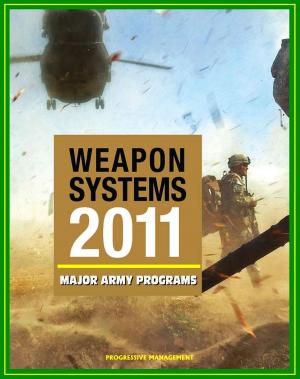Guide to Field Marshall William J. Slim: The Great General of World War II, Pivotal Role of Air Mobility in the Burma Campaign, Theoretical Thinking and the Impact of Theory on Campaign Planning
Nonfiction, History, Military, Aviation, World War II| Author: | Progressive Management | ISBN: | 9781310718786 |
| Publisher: | Progressive Management | Publication: | March 26, 2016 |
| Imprint: | Smashwords Edition | Language: | English |
| Author: | Progressive Management |
| ISBN: | 9781310718786 |
| Publisher: | Progressive Management |
| Publication: | March 26, 2016 |
| Imprint: | Smashwords Edition |
| Language: | English |
Professionally converted for accurate flowing-text e-book format reproduction, this unique book reproduces three reports and studies about Field Marshall William J. Slim and the famous Burma campaigns of World War II:
Field Marshal William J. Slim: The Great General and the Breaking of the Glass Ceiling - Slim Chance: The Pivotal Role of Air Mobility in the Burma Campaign - Field Marshal Slim - Theoretical Thinking and the Impact of Theory on Campaign Planning
Field Marshal William J. Slim is considered by many historians to be one of the finest generals of World War II. His accomplishments were truly extraordinary. He commanded a polyglot army, consisting of six different nationalities speaking eight different languages, that fought in some of the most inhospitable, disease-ridden country in the world against the war's toughest opponent, the Japanese. In March 1942, he assumed command of a British-Indian force in Burma half way through the longest retreat in the British Army's history. Even though he was unable to reverse the disaster, he kept his force intact and led it to safety. Over the next three and one half years, despite very limited resources and several inept senior commanders, he rebuilt his force into an army that was able to inflict on the Japanese their greatest land defeat of World War II. In the process, he conducted four of the most classic operational campaigns of the war-the battle of the Second Arakan; the battles of Kohima and Imphal; the capture of Mandalay and Meiktila; and the pursuit to Rangoon. Throughout his career, but especially during World War II, Slim met all the criteria for a great general and strategic leader as set forth in Lord Wavell's generals and generalship. Despite these great accomplishments, Slim ran into several "glass ceilings" during World War II. Twice he was relieved of command, once immediately after his greatest battlefield victory. This study examines Field Marshal' Slim's leadership. It takes a brief look at his biography, then compares him against Wavell's standards for generalship by highlighting events from his career that illustrate each standard. Finally, it addresses the issue of the "glass ceiling"--what it is, the events surrounding Slim's encounters with it, and how Slim was able to overcome it. The intent is to show that Slim was not only a great World War II general, but is still a model of leadership worthy of study by the U.S. Army.
This study applies lessons learned from air mobility's pivotal role in Field Marshal Sir William Slim's World War II Burma campaign to contemporary air mobility operations. The author begins by tracing the evolution of air mobility from its pre-World War I roots to the Second World War, noting how its development proceeded despite the lack of coherent, codified doctrine. Next the author assesses Slim's Burma campaign and how the key elements of organization, training and leadership, apart from air mobility, proved critical to Allied victory. Building upon this, the discussion turns to air mobility's contributions to Slim's joint campaign. From this analysis, the author identifies the tenets of air superiority, organization and air mobility normalization as being critical and enduring airpower lessons from the Burma theater. The closing chapters offer a primer on contemporary mobility operations before arguing that modern air mobility practitioners must account for five key essentials: superiority across the air and space domains; proper organization that promotes relationship building at the operational level of war; normalization of the complete air mobility supply chain and its accompanying idea of "air mobility mindedness"; training focused on increased interoperability; and the vital role of leadership.
Professionally converted for accurate flowing-text e-book format reproduction, this unique book reproduces three reports and studies about Field Marshall William J. Slim and the famous Burma campaigns of World War II:
Field Marshal William J. Slim: The Great General and the Breaking of the Glass Ceiling - Slim Chance: The Pivotal Role of Air Mobility in the Burma Campaign - Field Marshal Slim - Theoretical Thinking and the Impact of Theory on Campaign Planning
Field Marshal William J. Slim is considered by many historians to be one of the finest generals of World War II. His accomplishments were truly extraordinary. He commanded a polyglot army, consisting of six different nationalities speaking eight different languages, that fought in some of the most inhospitable, disease-ridden country in the world against the war's toughest opponent, the Japanese. In March 1942, he assumed command of a British-Indian force in Burma half way through the longest retreat in the British Army's history. Even though he was unable to reverse the disaster, he kept his force intact and led it to safety. Over the next three and one half years, despite very limited resources and several inept senior commanders, he rebuilt his force into an army that was able to inflict on the Japanese their greatest land defeat of World War II. In the process, he conducted four of the most classic operational campaigns of the war-the battle of the Second Arakan; the battles of Kohima and Imphal; the capture of Mandalay and Meiktila; and the pursuit to Rangoon. Throughout his career, but especially during World War II, Slim met all the criteria for a great general and strategic leader as set forth in Lord Wavell's generals and generalship. Despite these great accomplishments, Slim ran into several "glass ceilings" during World War II. Twice he was relieved of command, once immediately after his greatest battlefield victory. This study examines Field Marshal' Slim's leadership. It takes a brief look at his biography, then compares him against Wavell's standards for generalship by highlighting events from his career that illustrate each standard. Finally, it addresses the issue of the "glass ceiling"--what it is, the events surrounding Slim's encounters with it, and how Slim was able to overcome it. The intent is to show that Slim was not only a great World War II general, but is still a model of leadership worthy of study by the U.S. Army.
This study applies lessons learned from air mobility's pivotal role in Field Marshal Sir William Slim's World War II Burma campaign to contemporary air mobility operations. The author begins by tracing the evolution of air mobility from its pre-World War I roots to the Second World War, noting how its development proceeded despite the lack of coherent, codified doctrine. Next the author assesses Slim's Burma campaign and how the key elements of organization, training and leadership, apart from air mobility, proved critical to Allied victory. Building upon this, the discussion turns to air mobility's contributions to Slim's joint campaign. From this analysis, the author identifies the tenets of air superiority, organization and air mobility normalization as being critical and enduring airpower lessons from the Burma theater. The closing chapters offer a primer on contemporary mobility operations before arguing that modern air mobility practitioners must account for five key essentials: superiority across the air and space domains; proper organization that promotes relationship building at the operational level of war; normalization of the complete air mobility supply chain and its accompanying idea of "air mobility mindedness"; training focused on increased interoperability; and the vital role of leadership.















